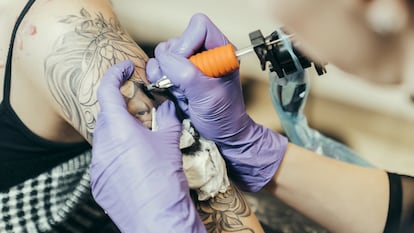The new tattoo landscape
Nowadays, young people are looking for more meaning in their tattoos. They have their favorite artists, who use empty skin to put together travelling art galleries

In a large warehouse transformed into a studio in the Vallecas neighborhood of Madrid, 33-year-old artist Ana Rodríguez (@ Polvo_eres) uses her fingertips to trace the silhouette of a child-style horse that she has tattooed on her left leg.
“This was made for me by a friend and it’s one of my favorites.”
Ana studied fine arts in Mexico and Spain. She has been dedicated to the world of tattooing for more than 10 years and notes that one of the styles she most admires in art is that of her little nephews.
Ana belongs to a generation of tattoo artists who have broken with the traditional style in pursuit of “freer” designs. In these artists’ Instagram portfolios, aggressive lines prevail, full of spikes and thorns, but also, as in the case of Ana, cuter illustrations, even bordering on childish.
“My clients tend to be, above all, non-binary people, women and people of color.” She is developing a project called Black and Brown are Beautiful, in which she dismisses the idea that you cannot tattoo color on dark skin.
Ana’s eyes are made up with double black lines. There are some small gems glued to her lower eyelids that crinkle every time she smiles. She speaks passionately about her influences and the artists she admires, such as Rita Salt or Simon Hanselmann. She is fascinated by porcelain figurines, the toys from the imaginarium where she once worked, Eastern European cartoon shows and comic books.
Alternative cartoonists, like Jim Woodring, are the backbone of many of these new tattoo artists. One who is particularly influenced by Woodring is 30-year-old Ramón Duerto (@nadabien), one of the most popular tattoo artists beyond the underground scene. He has made designs for the band Carolina Durante and, recently, for the cover of Facendera, the debut novel of poet Óscar García Sierra.
At Casa Antillón, a collective studio and art space located in the Carabanchel district of Madrid, Duerto walks past a large seesaw and tables covered in leather scraps. He reaches his desk, where some sketches of cows, angels and goblins await. Among his references are the illustrators Michael Deforge and Jesse Jacobs, although the first tattoo he did was “the lyrics of a song by Mobb Deep, an American rap duo.”
One of Duerto’s first clients was his mother. “I made a star on her wrist with a sewing needle and ink. Now she has both arms covered and wants me to tattoo a dragon on her leg.”
Duerto alternates tattooing with a machine and by hand, or handpoke, a technique that is often mistakenly confused with a style: “You can tattoo the same thing using one technique or another,” he says.
Some colleagues from the workshop approach to ask for help with an airbrush. Ramón gently takes it and looks at the machine through his small round glasses. Without saying much, he searches through his tattoo tools, disassembles one of the devices, takes out a tiny piece and gives it to his companions. “This should work”.
Duerto speaks of “unconventional tattooing.” Both he and Ana highlight the importance of the Ignorant, a movement that was born from the need to break with the standardization of graffiti, which was developed in the world of painting and fashion, eventually settling on the field of tattooing.
Nowadays, young people are looking for more meaning in their tattoos. They have their favorite artists, who use empty skin to put together travelling art galleries.
“What happened to tattooing is that it became a very inbred art,” says 27-year-old Leopoldo Mata (@le__polo). “Many creative disciplines have gotten more flexible over time, but tattooing has been more stagnant. We were tattooing sailors or Japanese letters for years… [things] that had nothing to do with our culture.”
Mata studied at the Faculty of Fine Arts in Cuenca, a cradle of artists who, among other things, are dedicated to unconventional tattoos. After leaving university, he moved to France and made tattooing his life. He found a good niche of clients in a Facebook group of Spaniards in Paris.
“I drew virgins, phrases, whatever they asked me to... I learned a lot and thanks to that experience, I realized what I didn’t want to do.”
He then began to create less conventional designs, upload them to Instagram and tattoo whoever wanted to do it on their skin. He travelled around the world and saw how his style of tattooing was better received in London, Germany and the United States than in Spain.
“I like the world of tattoos a lot but it doesn’t fill me with everything I need… it’s hard for me to change, evolve and try new things without losing the taste of the public.”
Tu suscripción se está usando en otro dispositivo
¿Quieres añadir otro usuario a tu suscripción?
Si continúas leyendo en este dispositivo, no se podrá leer en el otro.
FlechaTu suscripción se está usando en otro dispositivo y solo puedes acceder a EL PAÍS desde un dispositivo a la vez.
Si quieres compartir tu cuenta, cambia tu suscripción a la modalidad Premium, así podrás añadir otro usuario. Cada uno accederá con su propia cuenta de email, lo que os permitirá personalizar vuestra experiencia en EL PAÍS.
¿Tienes una suscripción de empresa? Accede aquí para contratar más cuentas.
En el caso de no saber quién está usando tu cuenta, te recomendamos cambiar tu contraseña aquí.
Si decides continuar compartiendo tu cuenta, este mensaje se mostrará en tu dispositivo y en el de la otra persona que está usando tu cuenta de forma indefinida, afectando a tu experiencia de lectura. Puedes consultar aquí los términos y condiciones de la suscripción digital.









































